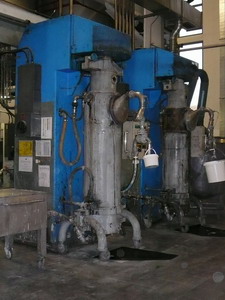Heat-up model
Heat-up losses correspond to progressive temperature increase during some production operations. For example, they can occur on many installations such as high-speed dispersers and ball mills illustrated bellow.


Heat-up model proposed by Envmodels can be used on installation when the amount of heat-up is small (in other case use heating model), and the final temperature is well below the boiling point of the liquid mixture.
Example:
A 5000 liters high-speed disperser contains 3500 liters of paint witch composition is 40% of non volatiles products (powder) and 60% of solvents. Solvent mixture composition is as follow:
- Toluene : 60%,
- Methyl isobutyl ketone : 40%.
Initial mixture temperature is 20°C and final temperature is 40°C. The yearly cycle number for that production is 50.
Total yearly VOC emission calculated for that heat-up operation is 1.546 kg.
For each product, yearly emission is as follow:
- Toluene : 1.049 kg,
- Methyl isobutyl ketone : 0.496 kg.
- EPA. 1994. Control of Volatile Organic Compound Emissions from Batch Processes - Alternate Control Techniques. U.S. Environmental Protection Agency, Office of Air Quality Planning and Standards, EPA-453/R-93-017.
- EIIP. 2005. Methods for Estimating Air Emissions from Paint, Ink and Other Coating Manufacturing Facilities Chapter 8 in EIIP Volume II.



